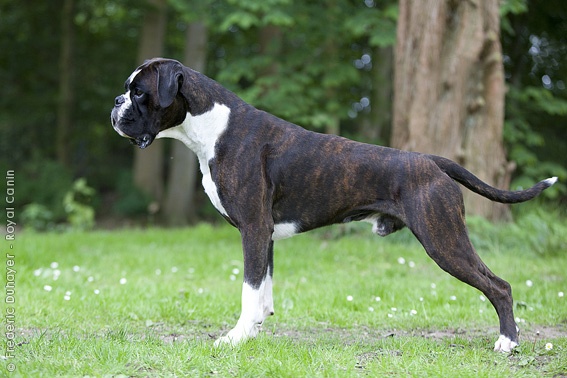
In any breed that includes the brindle marking pattern, such as Whippets, Cardigan Welsh Corgis, Plotts, Frenchies, Irish Wolfhounds, and Boxers, reverse brindling is possible.
A regular brindle pattern occurs when dark stripes appear over a lighter-colored background. In a reverse brindle pattern, however, the prominence of coloring is switched so that light stripes appear to sit on on a dark-colored background (such as fawn brindling on a black background). In actuality, the background hair is still a light or fawn color, but the dark stripes are so prominent that they give the coat an overall darker appearance. In fact, the coloring can almost look solid which gives a dog the appearance of being a dark color. Using the Boxer as an illustration, Boxers that appear black actually have a dark brindle coat, and those “stripes” will be visible upon close inspection. Some people refer to the heavy brindling that produces a dog to be almost black as seal brindling, but this isn’t a standard term, and especially when it’s erroneously referred to as sealed brindling. We’ve also seen the terms, “inverted brindle.”
Reverse brindling is rooted in genetics, of course, though to our knowledge, it can’t yet be predicted as to whether a dog will be a brindle or reverse brindle. Citing Boxers again, brindle is the dominant pattern, while the fawn is recessive. It takes two recessive fawn genes to display fawn coloring in puppies, while brindle Boxers will have only brindle-patterned pups if they have two brindle genes. If a brindle Boxer has both the dominant brindle gene and a recessive fawn gene, he or she can have fawn or brindle colored puppies as long as he or she is mated to a Boxer who also has the dominant brindle gene and a recessive fawn gene or breed, or to a Boxer with two fawn genes.
Reverse brindle breeds, such as the Boxer, are registered as brindles, and we’re told it’s acceptable to refer to Boxers with reverse brindling as having “black” brindles. We also advised to never refer to such a dog as a “black Boxer” because the breed does not carry the gene for a black coat. As an aside, the opposite of the reverse brindle is the “light brindle” which describes a dog having very few brindle stripes.
We always defer to breed experts and invite insights into reverse brindling.
Image of a reverse brindle dog found on Pinterest but credited to Royal Canin and Frederic Dunayer whom we presume shot the photograph.
